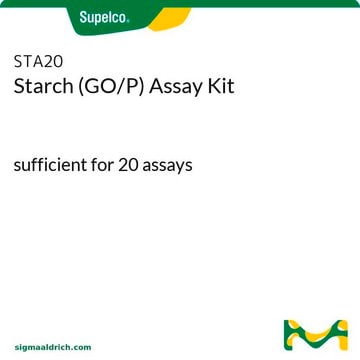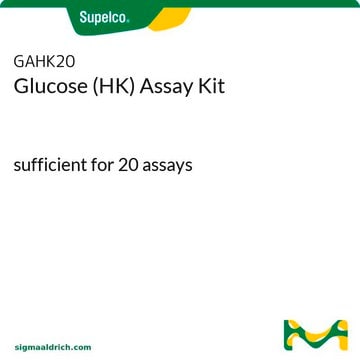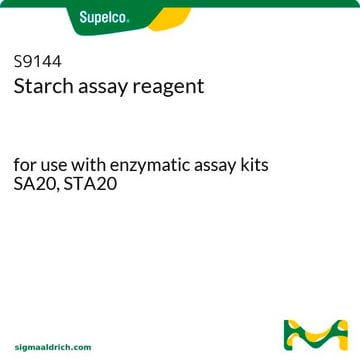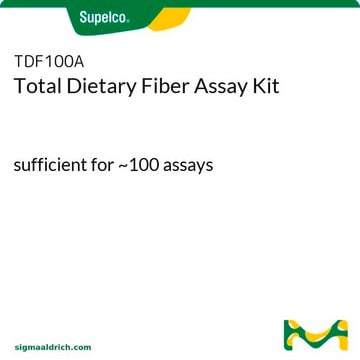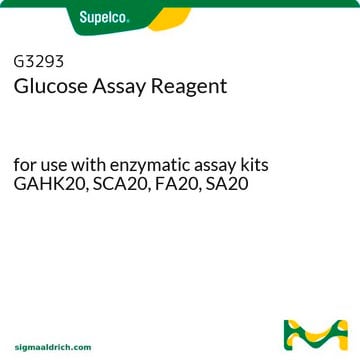SA20
Starch (HK) Assay Kit
sufficient for 20 assays
Synonym(s):
Starch Quantitation Kit
Sign Into View Organizational & Contract Pricing
All Photos(1)
About This Item
UNSPSC Code:
12164500
NACRES:
NA.84
Recommended Products
usage
sufficient for 20 assays
analyte chemical class(es)
sugars
technique(s)
photometry: suitable
application(s)
food and beverages
general analytical
storage temp.
2-8°C
Application
This kit is for the quantitative, enzymatic determination of native starch in food and other materials using the amyloglucosidase-hexokinase-glucose 6-phosphate dehydrogenase enzymatic assay. The hydrolysis of starch to glucose is catalyzed by amyloglucosidase. Glucose is phosphorylated by adenosine triphosphate (ATP) in the reaction catalyzed by hexokinase. Glucose-6-phosphate (G6P) is then oxidized to 6-phosphogluconate in the presence of nicotinamide adenine dinucleotide (NAD) in a reaction catalyzed by glucose-6-phosphate dehydrogenase (G6PDH). During this oxidation, an equimolar amount of NAD is reduced to NADH. The increase in absorbance at 340 nm is directly proportional to the glucose concentration.
Kit Components Only
Product No.
Description
- glucose assay reagent 20 mL
- starch assay reagent 1 mL/vial
- starch assay standard 5 g
related product
Product No.
Description
Pricing
Signal Word
Warning
Hazard Statements
Precautionary Statements
Hazard Classifications
Eye Irrit. 2 - Skin Irrit. 2 - STOT SE 3
Target Organs
Respiratory system
Storage Class Code
11 - Combustible Solids
Certificates of Analysis (COA)
Search for Certificates of Analysis (COA) by entering the products Lot/Batch Number. Lot and Batch Numbers can be found on a product’s label following the words ‘Lot’ or ‘Batch’.
Already Own This Product?
Find documentation for the products that you have recently purchased in the Document Library.
Customers Also Viewed
Amelia Torcello-Gómez et al.
Food chemistry, 272, 18-25 (2018-10-13)
An innovative procedure for plant chloroplasts isolation has been proposed, which consists of juice extraction by physical fractionation from plant material and recovery of its chloroplast-rich fraction (CRF) by centrifugation. This simple method has been applied to pea vine haulm
Yeon Jeong Kim et al.
PloS one, 7(9), e44493-e44493 (2012-09-13)
Protein disulfide isomerase (PDI) is a chaperone protein involved in oxidative protein folding by acting as a catalyst and assisting folding in the endoplasmic reticulum (ER). A genome database search showed that rice contains 19 PDI-like genes. However, their functions
Jianhua Fan et al.
Frontiers in plant science, 8, 1997-1997 (2017-12-07)
Concentrating algal cells by flocculation as a prelude to centrifugation could significantly reduce the energy and cost of harvesting the algae. However, how variation in phenotypic traits such as cell surface features, cell size and motility alter the efficiency of
Xiao-Fei Shen et al.
Water research, 81, 294-300 (2015-06-18)
In this study the heterotrophic cultivation of Chlorella vulgaris NIES-227 fed with glucose was investigated systematically using six media types; combinations of nitrogen repletion/depletion and phosphorus repletion/limitation/depletion. It was found that a high yield of fatty acids (0.88 of fed
Nazareth Torres et al.
Frontiers in plant science, 12, 633600-633600 (2021-03-12)
Majority of viticulture regions are located in mid-latitudes characterized by weather variability and stressful environments relying on irrigation for mitigating environmental stress during the growing season and to ensure a profitable yield. The aim of this study was to characterize
Our team of scientists has experience in all areas of research including Life Science, Material Science, Chemical Synthesis, Chromatography, Analytical and many others.
Contact Technical Service